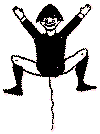By Dan Beard

Fig. 249
Dancing-Jack Showing the Position of Legs for Swimming
After you have gained confidence in your support, practice the frog's kick. Never mind your arms; It is possible to swim without them, as the frog has shown us. Do not draw your knees up under you, but spread your legs apart like a dancing-jack (Fig. 249)with your knees on each side. This, as has been shown, is the bull-frog's style. He knows his business and will take no points from us, though we may with advantage take some from him.
In kicking, strike the soles of your feet against the water as you would against the foot-board, were you lying face downward on your bed, and, like the frog, push the water from you. Finish the kick with the feet wide apart, then bring your legs close together, extending them in a straight line. At this point your toes must be turned down and your heels raised as far as possible, to lessen the resistance as you glide through the water. And glide you will, if the peg in the ducking-post is well greased and the kick properly made.
Do not be in a hurry to make the next kick. There is time enough to do that when the impulse forward that the first kick gave is dying out. Many old swimmers make the mistake of hurrying their kick and thus losing speed while making double the exertion necessary. T he Breast Stroke.
Gus Sundstrom, the champion long-distance swimmer and swimming master at the New York Athletic Club, in an article published ten years ago in the Harper's Young People, states that "this is the stroke that frogs use and always have used." Well, we will go to Gus to learn to swim, for he is a past grand master of the art. But we prefer to watch a frog ourselves, and by so doing we shall see that he does not use his little short arms, or his funny hands, with no web between the fingers. As already stated, he depends entirely upon his long muscular legs and big webbed feet to propel him through the water. So, in place of going to Mr. Frog for the breast stroke, we prefer to go to Gus, for he has no webbed feet and does depend upon his hands and arms to help propel himself.
He says that when you strike out you must "hold your fingers close together." Perhaps one of the principal uses of man's hands in the water is keeping his head up, so that he may breathe, and that is why he makes the stroke a little downward, for by pressing on the water he lifts his head.